In the Eburu Forest, sustainable fruit farming is replacing logging and poaching, while providing jobs that protect endangered species and rich habitats.
November 27, 2020
In the foothills of Mount Eburu, 100 kilometers northwest of Nairobi, Kenya, farmers tend to lush green orchards and vegetable gardens. These farms represent the Eburu Fruit Farmers Association, a community-based organization that promotes sustainable development through farming in a way that does not interfere with the ecosystem of the surrounding Eburu Forest.

The organization started with 72 members in 2014. It has since grown across five villages. Many of the farmers are former poachers. For that reason, the Eburu Fruit Farmers Association has provided sustainable job opportunities that replace destructive, extractive activities. “The organization is really supporting us,” said Josephat Maina, a plum farmer. “It has hired experts to assist us perform better agricultural practices in our farms to make this project profitable and sustainable.”
Eburu Forest is a precious ecosystem, rich in biodiversity. Comprising nearly 9,000 hectares around Mount Eburu, the forest includes steep valleys, springs, waterfalls, and various native tree species, such as the African cherry (Prunus africana) and the African pencil Cedar (Juniperus procera). This forest is the easternmost of 22 preserved forest blocks that form the vast Mau Forest Complex of Kenya’s Rift Valley. This area makes up the largest montane forest in East Africa.
Eburu Forest is well known as a hotspot for birdlife within the greater Mau Forest Complex, which is the main water catchment area for several rivers that drain into Lake Victoria. It hosts more than 60 species of animals, including the mountain bongo antelope, a critically endangered species restricted to a few upland forests in the Aberdare Ranges, Mount Kenya, and the Mau Eburu Complex. There are an estimated 120 mountain bongos left. Twelve of them are known to live in Eburu.
In the past few decades, the Mau Eburu Complex has been severely degraded by agriculture, charcoal burning, logging, and poaching. In an effort to protect the forests, the Kenyan government set up a 15-mile buffer zone around the forest complex and has since evicted more than 50,000 people from Mau Forest lands, including more than 40,000 in July 2018 and the rest between August and November 2019. According a July 2020 report by Human Rights Watch, at least 6,000 of the people recently evicted are living in harsh conditions in makeshift camps in Narok county and have not been relocated or compensated as required under Kenyan law.
Amid this scenario, community-based efforts like the Eburu Fruit Farmers Association offer a sustainable way forward that ensure both ecosystem protection and viable livelihoods for villagers living in and around the Mau Eburu Complex.
In 2014, in cooperation with local communities, conservation organization Rhino Ark fenced off 44 square kilometers of the vast Mau Eburu forest ecosystem as part of an ongoing effort to minimize human-wildlife conflict. The Eburu Fence Project was just one of Rhino Ark’s many initiatives to protect forest ecosystems from illegal logging, charcoal burning, and poaching. The success of the fence rests on the cooperation of the local community, who build and maintain it.
In the Eburu Forest, the new electric fence meant that neighboring villages dependent on the forest for logging and hunting had to shift their livelihood to farming. Rhino Ark supported the Eburu Fruit Farmers Association and taught villagers best agricultural practices to increase productivity and boost their yields and incomes. (The fence, in turn, provides farmers greater security for their crops.)
The farmers now grow tree tomatoes and plum fruits, which they sell in the nearby towns of Naivasha, Gilgil, and Nakuru. Some farmers have added value to their produce by extracting juice. At the moment, the active members own almost 7,000 fruit trees, with plans to expand.
Three times per month, a team of graduate students and agricultural experts from the Kenya Agricultural & Livestock Research Organization visit the Eburu fruit farms to ensure that the farmers there are following the best agricultural practices to make the initiative profitable to the community to the betterment of the forest ecosystem.
“In a month, a farmer can make about $300,” said Lydia Nyota, chairperson of the Eburu Fruit Farmers Association. “With this amount he has no reason to go in the forest to hunt or cut trees.”
Nyota said that nowadays, farmers in Eburu earn a better living than before, when they used to go to the forest to collect firewood and logs. These logging excursions, she said, were especially dangerous to women. The farms have also given poachers a chance to make a living without harming endangered species. Plus, the forest is now fully guarded by the Kenya Forest Service, Kenya Wildlife Service, and the community. According to Dennis Kerengo, a conservator with the Kenya Forest Service, logging has drastically reduced in Eburu forest by a huge margin as nobody is allowed to enter the forest without the permission from the relevant authority. Kerengo also said that 60 percent of the forest area that had been disturbed by charcoal burning and logging has been reinstated.
Rhino Ark’s Ccommunity Manager John Motong’u said that the project has been beneficial both to the farmers and to the entire Eburu Forest ecosystem. “This project is among those we have done extremely well,” said Motong’u. “It has enabled us to conserve the critically endangered bongos while at the same time giving farmers a sustainable source of income. The project has also drastically reduced logging and poaching which was ramped some years ago.”
"fruit" - Google News
November 28, 2020 at 02:07AM
https://ift.tt/2V95WJV
Kenyan Fruit Farmers Tend Orchards to Protect Wildlife - Earth Island Journal
"fruit" - Google News
https://ift.tt/2pWUrc9
https://ift.tt/3aVawBg
Bagikan Berita Ini















0 Response to "Kenyan Fruit Farmers Tend Orchards to Protect Wildlife - Earth Island Journal"
Post a Comment